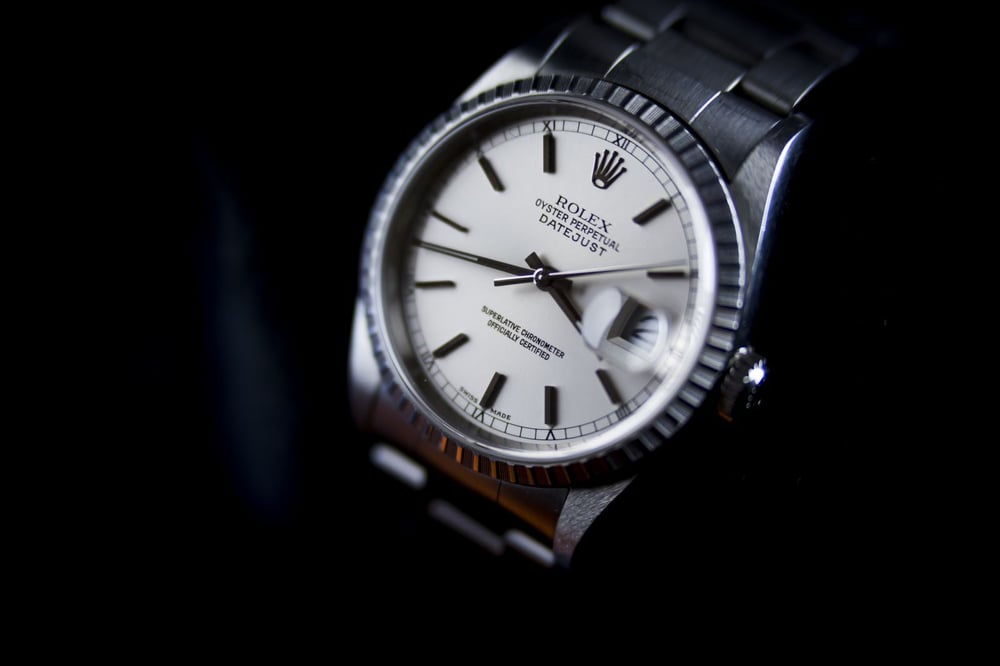The Rolex Datejust: History, Examples and Market Value
Of all the models in Rolex’s 120-year catalogue, the Datejust stands out as one of its most enduring creations – second only to the Submariner in its ubiquity. Introduced in 1945 to mark the brand’s 40th anniversary, the Datejust showcased a deceptively simple innovation that would go on to shape modern watchmaking: the date window. The inaugural reference 4467 was the world’s first self-winding chronometer wristwatch to display the date automatically – a feature so commonplace today that it’s easy to forget it once marked a technical breakthrough.
The Datejust quickly rose to prominence, embraced by prime ministers, presidents, and celebrities. One of the most notable early owners was Winston Churchill. In 1947, as Rolex celebrated the production of its 100,000th officially certified chronometer, founder Hans Wilsdorf marked the occasion by presenting a handful of Datejusts to world leaders. Churchill’s example was a gold reference engraved with his family crest, which he described as “a continual pleasure” that “works admirably.” Dwight D. Eisenhower received a similar gift, calling it one of his “proud possessions” that had brought him “a great deal of satisfaction.”
While other Rolex models are tied to pursuits – diving, racing, aviation – the Datejust speaks to something broader. The archetypal dress watch isn’t defined by extremes or achievements, but by permanence and presence, built for everyday wear.

The Datejust – A Watch for the Post-War World
The timing of the Datejust debut was no coincidence. Headquartered in Geneva, Rolex had been largely insulated from the destruction of the Second World War and was already looking ahead. When the Datejust was unveiled in 1945, the war had just ended, Europe was in recovery, and the future felt open-ended for the first time in years. The Datejust captured that optimism in the luxury market.
Beyond the novelty of the new date window, the model introduced what would become key elements of the brand’s visual identity. The first Datejust – reference 4467 – was crafted in yellow gold with a fluted bezel and a five-link bracelet designed specifically for the launch (the now-iconic Jubilee bracelet). Inside, it housed the calibre 710, a new self-winding movement protected by the patented Oyster case, which had already become a signature of Rolex durability and water resistance.
The Evolution of the Datejust – Notable Examples
The original reference 4467 laid the groundwork for what the Datejust would become, but over the years, the watch has taken on many forms. From statesman pieces to sportier outliers, these four examples showcase the breadth of this storied model.
Rolex Datejust Reference 6305/1 (The Eisenhower)
The reference 6305 generation was one of the first major evolutions of the Datejust line. It brought a more ornate bezel with creative dial options, from honeycomb textures to roulette date wheels, signalling a more expressive and personal form of watchmaking. It’s also the Datejust most closely associated with global leadership. In 1951, Hans Wilsdorf gifted a gold reference 6305 to Dwight Eisenhower – then a five-star general and soon-to-be President of the United States – with his initials and insignia engraved on the caseback. The piece came to auction in 2014 with high bids of $475,000, but it was withdrawn due to a non-original dial.
The reference 6305 saw success on the auction block in 2011, when a yellow gold example owned by West German Chancellor Konrad Adenauer (also gifted directly by Wilsdorf) sold at Sotheby’s Geneva for CHF 170,500.
Rolex Lady?Datejust
Today, the Datejust is as popular with women as it is with men. First introduced in 1957, the Lady-Datejust marked a real turning point in women’s watchmaking – offering a fully functional chronometer at a time when most women’s watches were treated primarily as jewellery. The Lady-Datejust carried the same calibre as its mid-sized counterparts, simply re-engineered for a smaller 25mm case (modern options include 28mm and 31mm).
Over the decades, the Lady-Datejust collection has evolved in tandem with the wider Datejust line, featuring everything from gem-set bezels and Jubilee bracelets to full diamond pavé dials. On the secondary market, vintage models in precious metals, particularly those with diamond hour markers or mother-of-pearl dials, are some of the most sought-after.
The Turn-O-Graph Datejust Reference 6202 (The Thunderbird)
Released at Basel Fair in 1953, the Turn-O-Graph Reference 6202 was an unusual outlier in the Datejust family. Originally positioned as a sportier alternative to the classic dress profile, it featured a black rotating bezel designed to time events – a precursor of sorts to the Submariner that would release shortly after. The Turn-O-Graph quickly caught the attention of the US Air Force aerobatic squadron, earning it the nickname ‘The Thunderbird’. Though short-lived in the broader Datejust lineage, it’s a compelling example of Rolex’s mid-century experimentation, and it can achieve up to $80,000 on the secondary market.
The Datejust 41 (2016–Present)
The latest variation of the Datejust – the Datejust 41 – arrived in 2016, slightly bigger than its predecessors at 41mm. Visually, it stays true to the blueprint, with a fluted bezel, Jubilee bracelet, and date window magnified under a Cyclops lens. Beneath the bezel however, is the new calibre 3235 – a self-winding movement with a 70-hour power reserve and Rolex’s patented Chronergy escapement, offering greater reliability and energy efficiency.
Since its debut, Rolex has released a variety of fashion-forward iterations that play on the flagship model. These include two-tone Rolesor versions with royal blue dials, Everose gold editions adorned with diamond hour markers, and the collector-favourite Datejust 41 ‘Wimbledon’ – easily recognised by its slate-grey dial and green Roman numerals. While not a rare collector’s piece in the traditional sense, select variations of the Datejust 41 are beginning to attract growing interest on the secondary market.
Final Thoughts
Once a symbol of post-war optimism in the luxury market, the Datejust remains one of Rolex’s best-selling models, as loved today as it was by the statesmen of the 1950s. Over the past eighty years, it has stayed aesthetically relevant through every shift in fashion – a lasting gesture of both good taste and quiet power.



